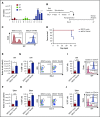Driver mutations in Janus kinases in a mouse model of B-cell leukemia induced by deletion of PU.1 and Spi-B
- PMID: 30355579
- PMCID: PMC6234372
- DOI: 10.1182/bloodadvances.2018019950
Driver mutations in Janus kinases in a mouse model of B-cell leukemia induced by deletion of PU.1 and Spi-B
Abstract
Precursor B-cell acute lymphoblastic leukemia (B-ALL) is associated with recurrent mutations that occur in cancer-initiating cells. There is a need to understand how driver mutations influence clonal evolution of leukemia. The E26-transformation-specific (ETS) transcription factors PU.1 and Spi-B (encoded by Spi1 and Spib) execute a critical role in B-cell development and serve as complementary tumor suppressors. Here, we used a mouse model to conditionally delete Spi1 and Spib genes in developing B cells. These mice developed B-ALL with a median time to euthanasia of 18 weeks. We performed RNA and whole-exome sequencing (WES) on leukemias isolated from Mb1-CreΔPB mice and identified single nucleotide variants (SNVs) in Jak1, Jak3, and Ikzf3 genes, resulting in amino acid sequence changes. Jak3 mutations resulted in amino acid substitutions located in the pseudo-kinase (R653H, V670A) and in the kinase (T844M) domains. Introduction of Jak3 T844M into Spi1/Spib-deficient precursor B cells was sufficient to promote proliferation in response to low IL-7 concentrations in culture, and to promote proliferation and leukemia-like disease in transplanted mice. We conclude that mutations in Janus kinases represent secondary drivers of leukemogenesis that cooperate with Spi1/Spib deletion. This mouse model represents a useful tool to study clonal evolution in B-ALL.
© 2018 by The American Society of Hematology.
Conflict of interest statement
Conflict-of-interest disclosure: The authors declare no competing financial interests.
Figures








Similar articles
-
Janus Kinase Mutations in Mice Lacking PU.1 and Spi-B Drive B Cell Leukemia through Reactive Oxygen Species-Induced DNA Damage.Mol Cell Biol. 2020 Aug 28;40(18):e00189-20. doi: 10.1128/MCB.00189-20. Print 2020 Aug 28. Mol Cell Biol. 2020. PMID: 32631903 Free PMC article.
-
PU.1 opposes IL-7-dependent proliferation of developing B cells with involvement of the direct target gene bruton tyrosine kinase.J Immunol. 2015 Jan 15;194(2):595-605. doi: 10.4049/jimmunol.1401569. Epub 2014 Dec 10. J Immunol. 2015. PMID: 25505273
-
N-Acetylcysteine Alters Disease Progression and Increases Janus Kinase Mutation Frequency in a Mouse Model of Precursor B-Cell Acute Lymphoblastic Leukemia.J Pharmacol Exp Ther. 2024 Mar 15;389(1):40-50. doi: 10.1124/jpet.123.002000. J Pharmacol Exp Ther. 2024. PMID: 38336380
-
PU.1: a crucial and versatile player in hematopoiesis and leukemia.Int J Biochem Cell Biol. 2008;40(1):22-7. doi: 10.1016/j.biocel.2007.01.026. Epub 2007 Feb 4. Int J Biochem Cell Biol. 2008. PMID: 17374502 Review.
-
Mouse models in the study of the Ets family of transcription factors.Oncogene. 2000 Dec 18;19(55):6443-54. doi: 10.1038/sj.onc.1204038. Oncogene. 2000. PMID: 11175360 Review.
Cited by
-
Single-cell transcriptome analysis profiles the expression features of TMEM173 in BM cells of high-risk B-cell acute lymphoblastic leukemia.BMC Cancer. 2023 Apr 24;23(1):372. doi: 10.1186/s12885-023-10830-5. BMC Cancer. 2023. PMID: 37095455 Free PMC article.
-
ANP32B suppresses B-cell acute lymphoblastic leukemia through activation of PU.1 in mice.Cancer Sci. 2023 Jul;114(7):2882-2894. doi: 10.1111/cas.15822. Epub 2023 May 3. Cancer Sci. 2023. PMID: 37137487 Free PMC article.
-
IRF4 deficiency vulnerates B-cell progeny for leukemogenesis via somatically acquired Jak3 mutations conferring IL-7 hypersensitivity.Cell Death Differ. 2022 Nov;29(11):2163-2176. doi: 10.1038/s41418-022-01005-z. Epub 2022 Apr 22. Cell Death Differ. 2022. PMID: 35459909 Free PMC article.
-
Longitudinal Single-Cell Dynamics of Chromatin Accessibility and Mitochondrial Mutations in Chronic Lymphocytic Leukemia Mirror Disease History.Cancer Discov. 2021 Dec 1;11(12):3048-3063. doi: 10.1158/2159-8290.CD-21-0276. Cancer Discov. 2021. PMID: 34112698 Free PMC article.
-
Janus Kinase 3 (JAK3): A Critical Conserved Node in Immunity Disrupted in Immune Cell Cancer and Immunodeficiency.Int J Mol Sci. 2024 Mar 4;25(5):2977. doi: 10.3390/ijms25052977. Int J Mol Sci. 2024. PMID: 38474223 Free PMC article. Review.
References
-
- Siegel R, Ma J, Zou Z, Jemal A. Cancer statistics, 2014. CA Cancer J Clin. 2014;64(1):9-29. - PubMed
-
- Pui CH, Robison LL, Look AT. Acute lymphoblastic leukaemia. Lancet. 2008;371(9617):1030-1043. - PubMed
-
- Buchner M, Swaminathan S, Chen Z, Müschen M. Mechanisms of pre-B-cell receptor checkpoint control and its oncogenic subversion in acute lymphoblastic leukemia. Immunol Rev. 2015;263(1):192-209. - PubMed
Publication types
MeSH terms
Substances
Grants and funding
LinkOut - more resources
Full Text Sources
Molecular Biology Databases
Research Materials
Miscellaneous

